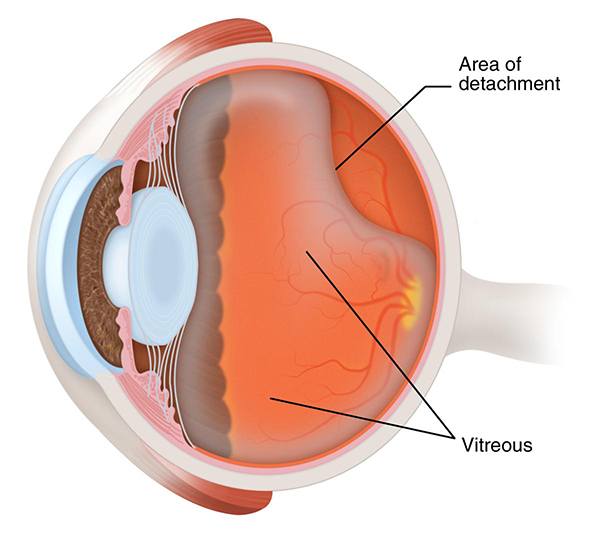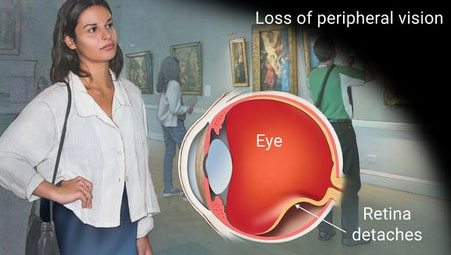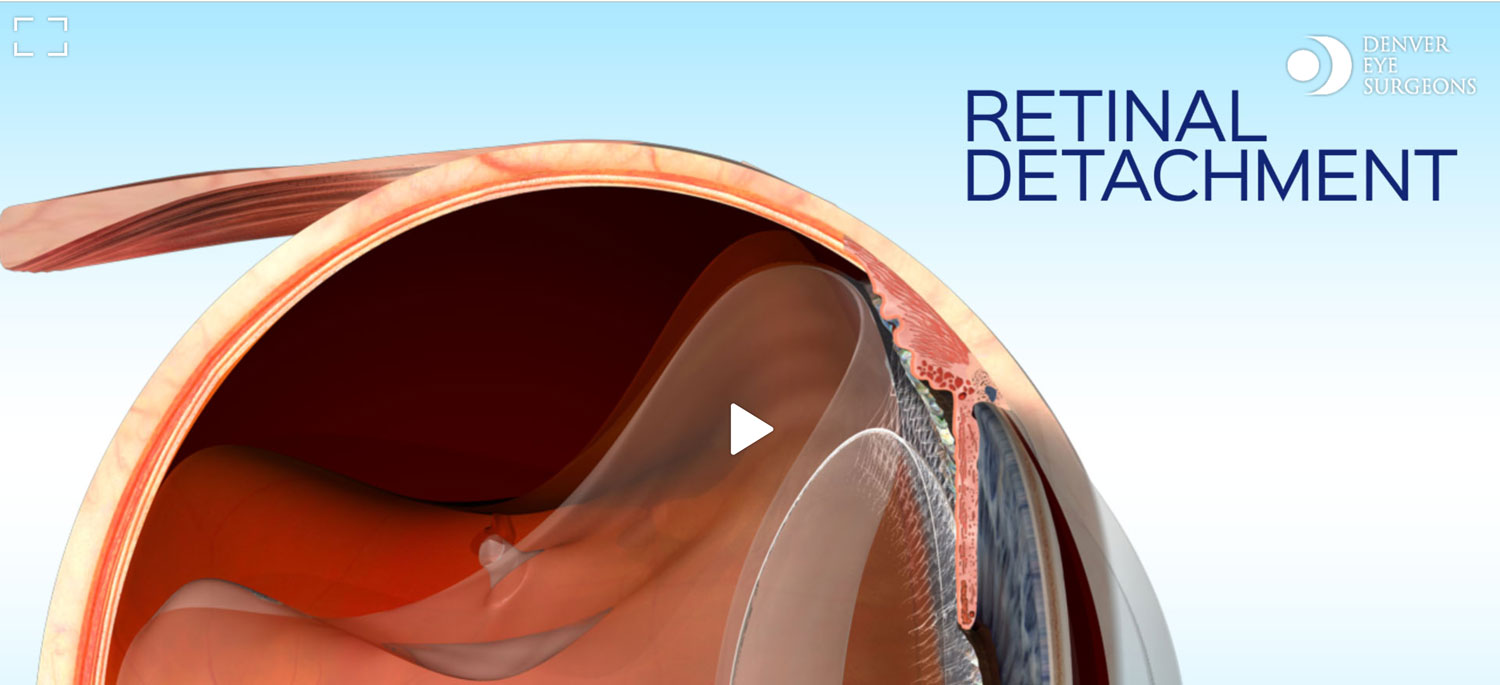
I see a light flash in the corner of my eye, should I be concerned?

What are these light flashes?
The flashes you see in your eye are a type of photopsia or vision disturbance. The light flashes almost seem like “shooting stars” or “lightning streaks.” These flashes of light come from inside your eye and not from any external source.
Where do the flashes originate from?
Retinal detachment is a disorder of the eye in which the retina peels away from its underlying layer of support tissue. In most cases, it is a result of internal changes in the vitreous fluid. The vitreous fluid is a clear jelly-like fluid and takes up a large part of the back of your eye, where 99% consists of water and the rest is a mixture of collagen, proteins, salts, and sugars. Its vital role is to help maintain the shape of the eye and the pressure of the vitreous helps to keep the retina in place.

Figure 1: Retinal detachment within the eye
Source: https://www.denvereyesurgeons.com/retinal-detachment-denver.htm
Follow the link below for an informative video about retinal detachment:
Why do you see light flashes?
The retina is a thin layer of light-sensitive tissue on the back wall of the eye. The optical system is much like the light that focuses on the film in a camera. The retina translates this focused image into neural impulses and transmits them to the brain via the optic nerve. Over time these fibres in the vitreous fluid become ‘stringy’ and float around the vitreous and cast a shadow on the retina. These are called floaters, you may notice it as specks, strings, or different types of shapes in your vision.
When these fibres get pulled or rubbed, they can cause flashes or light sparks from the friction. It can happen in one or both eyes and may vary in frequencies and duration.
What are the causes of these flashes?
There are many reasons why you may see light flashes. The flashes you experience are typically a result of an unrelated underlying condition.
It affects about one out of 10 000 people and may occur at any age. This condition usually occurs in middle-aged or older individuals because of the internal changes in the vitreous fluid associated with ageing.
Some retinal detachments can happen due to near-sightedness (myopia), diseases like severe inflammations, tumours, complications from diabetes or previous eye surgery. These are called secondary detachments. They do not always need surgery and can improve by treating the underlying cause depending on the severity.
There are three types of retinal detachment:
Each of them has its own set of causes that trigger the specific type of detachment.
1. Rhegmatogenous retinal detachment:
This is the most common detachment and occurs due to a retina hole or tear that allows fluid to pass through the hole and detaches from the retina. It is usually caused by ageing, as the vitreous gel pulls away from your retina. Other causes can be eye injury, surgery or near-sightedness.
2. Exudative, serous or secondary retinal detachment:
This detachment happens when fluid accumulates underneath your retina without the presence of a hole, tear, or break—usually caused by inflammation, injury, age-related macular degeneration, or vascular abnormalities.
3. Tractional retinal detachment:
This type occurs when scar tissue because of injury, inflammation, or neovascularization pulls on your retina.
Will I experience any symptoms?
You may experience no symptoms if only a tiny part of your retina detaches.
Some of the symptoms you may well experience is:
- Sudden increase in the amount of floaters in your eye.
- Flashes of light in one or both eyes.
- Permanently blurred vision.
- Gradually reduced side (peripheral) vision.
- A curtain-like shadow over parts of your visual field.

Figure 2: Curtain-like shadow in visual field
Source: https://firsteyecaredowntowndallas.com/eye-and-vision-health/eye-diseases/retinal-detachment/
Remember, you will feel no pain. Retinal detachment usually begins at the thin peripheral edge of the retina and extends gradually towards the more central area. If this happens, you will notice a shadow that starts peripherally, increase in size, and slowly encroaches on the central vision (straight-ahead gaze). But when your eyesight is distorted, wavy and indistinct, it is a medical emergency, and you should contact your Eye Specialist, if you do not have one, I can help with the arrangements.
Retinal detachment must be halted or treated immediately. It can lead to vision loss or even total blindness. This condition, unfortunately, does not heal spontaneously.
Can it be treated?
There are several treatment methods, and it depends on how much of your retina detaches and what type of detachment you have.
It all depends on the three different types of detachments you are diagnosed with and the accompanying severity.
The aim of the treatment is to find and repair the tears in the retina (if any) and to drain the subretinal fluid (fluid beneath the retina). Sometimes a combination of treatments is used.
Your treatment may involve one or more of these procedures:
- Laser (thermal) or freezing (cryopexy). Both methods can repair a tear if diagnosed early enough.
- Pneumatic retinopexy. This procedure works well for a tear that’s small and easy to close. A small gas bubble is injected into your vitreous gel. It presses against the upper part of your retina, closing the tear. You’ll need to hold your head in a specific position for several days to keep the bubble in the right place.
- Scleral buckle. An invisible silicone band gets permanently attached around the white of your eye (called the sclera). It pushes towards the tear or detachment until it heals.
- Vitrectomy. This surgery repairs large tears or detachments, and with this procedure, the vitreous gel is removed and replaced with a gas bubble or oil. A vitrectomy also might require you to hold your head in one position for some time.
About 80% to 90% of retina procedures are successful and might result in follow up appointments. It may take several months for your vision to return. Some people don’t get all their vision back, especially in more severe cases or if the macula (responsible for central vision) is involved.
If you experience any symptoms of a retinal detachment, it would be best if you act immediately.
Love Your Eyes!
Elke Smit

Elke is the owner of Eyestyle Optometrist. Her passion is to promote eye health and eye care but she is even more passionate about the people behind the eyes. The most important factor is good eyesight which gives us the ability to see the beauty in all things around us.
Your eyes are the window to your soul and most spectacle wearers wear their glasses for the better part of the day.
Choosing the appropriate eyewear is not always easy! Eyewear should feel comfortable, and suitable for everyday challenges.


